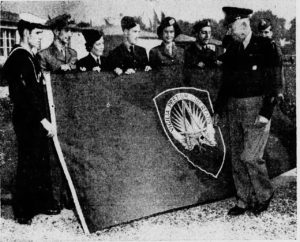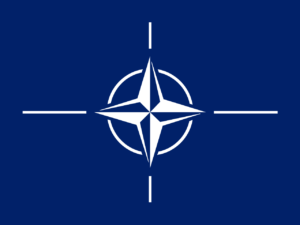The first flag used by NATO was unveiled October 5, 1951, by Gen. Dwight Eisenhower, who helped design it. The 1951 flag consisted of a green field with the coat of arms of the Supreme Headquarters Allied Powers Europe (SHAPE), which still uses the flag.

NATO began looking for an emblem to differentiate it from SHAPE, a task handled by the newly formed Information Policy Working Group. After several discussions, it concluded that a flag for the organization containing its emblem was necessary, and that it would recommend this to the North Atlantic Council. The council stipulated that the design had to be “simple and striking,” in addition to highlighting the “peaceful purpose” of the Treaty; several proposals were rejected.

An emblem of NATO was finally adopted on October 14, 1953. The decision was announced by Hastings Ismay, 1st Baron Ismay – the first Secretary General of NATO – exactly two weeks later on October 28, where he also elaborated on the symbolism behind the chosen design. He described the flag as “simple and inoffensive.” However, the flag was not universally well-received, and attracted criticism from for instance US Congressman John Travers Wood, who condemned the flag as a “strange and alien rag.” He made the remarks in light of an alleged incident where the flag of the United States was reportedly replaced by the NATO flag in Norfolk, Virginia, the headquarters of the Supreme Allied Commander Atlantic.
The modern flag was first hoisted on November 9, 1953, at the opening ceremony of the Atlantic Exhibition in Paris. However, little is known about the occasion, since no documentation of the speech delivered at the event exists.

Symbolism:
The colors of the flag carry cultural, political, and regional meanings. The dark blue field represents the Atlantic Ocean, while the circle stands for unity among the member states of NATO. The compass rose symbolizes the direction towards the path of peace, the goal that member states strive for; it has been updated once.
